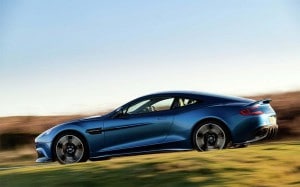
Best known for sleek sports cars like the new DB11, Aston Martin is plugging into alternative power, the British brand’s CEO telling TheDetroitBureau.com that all of its products will be offered with hybrid powertrains in the near future, while as much as a quarter of its line-up will go fully electric.
That shift reflects, in part, growing pressure from regulators around the world, even Britain now laying out what could be a forced shift away from internal combustion. But Chief Executive Andy Palmer stressed that Aston says that won’t necessarily be a bad thing for its buyers as it will use hybrid technology as much to boost performance as improve fuel economy.

An example of that will come with the arrival of the Valkyrie, the exotic hyper-car Aston unveiled at the Geneva Motor Show this year. Described by Palmer in an interview this week as “a symbol of our company, a symbol of what we can do,” the Valkyrie will use a Formula One-style KERS hybrid system to deliver over 1,000 horsepower, making it one of the most powerful vehicles offered on the retail market.
(F1-based Aston Martin Valkyrie supercar to make over 1,000 hp. Click Here for the story.)
“We’re taking Formula One technology and bringing it to the road,” said Palmer, during an interview near Barcelona, Spain where Aston is this week giving journalists a peek at a new version of its DB11 sports car. He emphasized that the Valkyrie will be just the first Aston to use an F1-based hybrid system, declaring the company’s intention that “every car by the middle of the 2020s will have an electric assist system.”

That will cover a broad range of products. Since the former Nissan product development chief signed on with Aston in late 2014, the British maker has worked up a broad expansion plan of what has traditionally been a narrow product range. The goal is to roll out seven new or completely updated models, starting with the 2016 launch of the DB11, one a year through 2022. And that doesn’t include special variants of those core products.
From a volume standpoint, the big hit will come in 2019 with the arrival of Aston Martin’s first sport-utility vehicle, the DBX. It is expected to be the brand’s best-seller, much as the Cayenne became for Porsche. All told, Palmer expects it to help boost Aston’s volume to as much as 17,000 a year, about 250% more than its prior annual record.
Palmer stressed that Aston won’t abandon those customers who want its traditional powertrain technology. It has completely redeveloped its familiar V-12 engines, and it has inked an alliance with Daimler AG – which now holds a 5% stake in the British company – to provide some of its AMG high-performance V-8s.
But Aston will offer hybrid versions of both its own twelve-cylinder engines and the AMG V-8s, explained Palmer. Both will rely on F1 KERS technology.
Short for Kinetic Energy Recovery System, KERS is, in some ways similar to the sort of hybrid technology found on mundane hybrid-electric vehicles like the Toyota Prius, recapturing energy traditionally lost during braking and coasting.

Like a Prius, this will improve fuel economy and, Palmer said, it will even allow an Aston to operate in fully electric mode for short distances. But Aston’s 42-volt hybrid system will primarily focus on using that power to boost the performance of its vehicles. The company’s system is still under development, but one way it may do so is by replacing conventional turbochargers with electric turbos. This will allow them to instantly “spool up” boost, rather than having to wait for exhaust pressure to build and begin spinning their turbines.
Aston isn’t the first automaker to say it is ready to offer electrify 100% of its products. Volvo recently announced it will only use battery-based drivetrains for all new models launched in 2018 and beyond. That includes conventional hybrids – which will account for the majority of its sales, it predicts – plug-in hybrids and pure battery-electric vehicles.
(For more on Volvo’s electrification plans, Click Here.)
One thing you won’t see in the Aston line-up, Palmer said, is a plug-in hybrid. Future products will go to the extremes: either high-performance hybrids or performance-oriented pure battery-electric vehicles.
The British brand’s first BEV was revealed in June. A limited-edition version of the Aston four-door that will be called the RapidE, it was developed as part of a joint venture with Chinese battery-car start-up LeEco. Beset by financial woes, LeEco has ended the partnership and Aston now says it will produce only 155 of the battery-electric vehicles. But Palmer says that will give his company a chance to see how the technology works and find ways to improve it for the future.
(Aston Martin parts ways with LeEco on RapidE EV program. Click Here for the story.)

Aston will be back with an EV drivetrain of its own, Palmer told TheDetroitBureau.com that will be “folder into one of our new products” around the 2021-2022 timeframe. “It will be one of the core cars,” he added.
The betting is that this new EV model will be a version of the DBX sport-ute. That model, with various drivetrain options, will readily account for the lion’s share of future Aston sales, if it meets the brand’s expectations.
The DBX platform will be large enough to contain the batteries necessary for long range, 200 to 300 miles per charge generally considered the bare minimum that future buyers will expect from an all-electric. As with the KERS hybrid system – and like the all-electric models from the likes of Tesla — Aston will put an emphasis on performance with future BEVs. But it also will meet new mandates expected to restrict sales of gas- and diesel-powered models in many global markets in the years ahead.
(An Aston Martin station wagon? No, a “shooting brake.” Click Here to check it out.)







